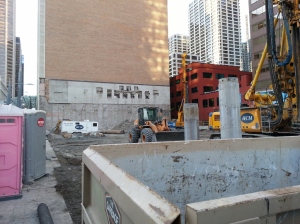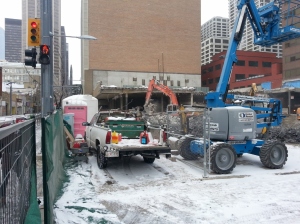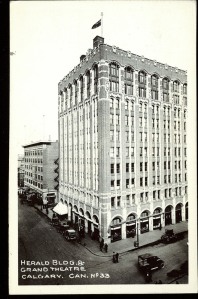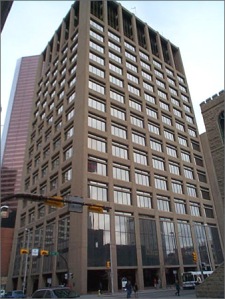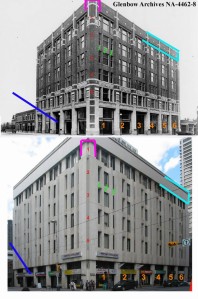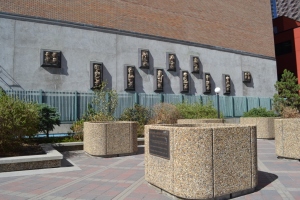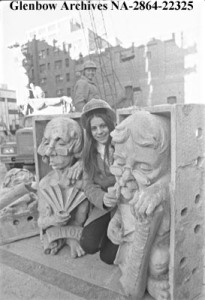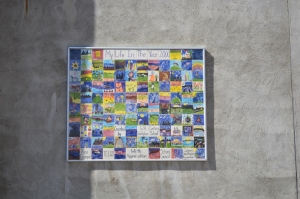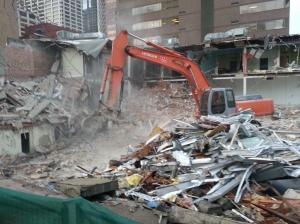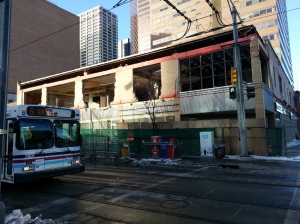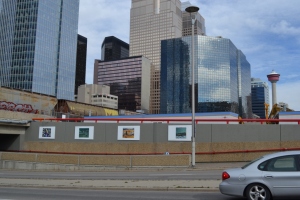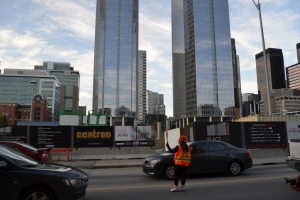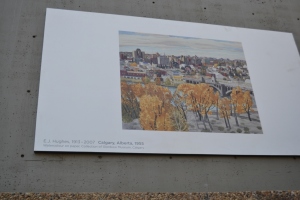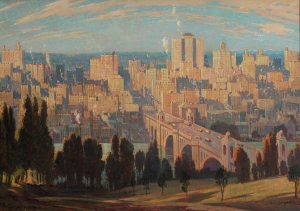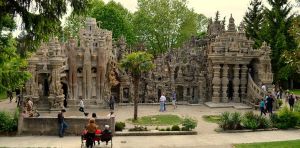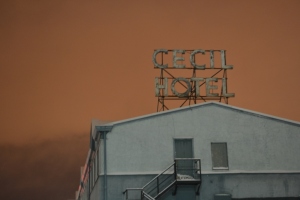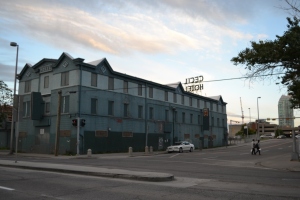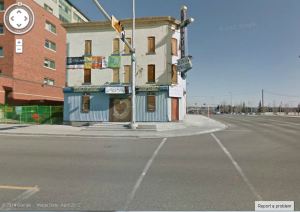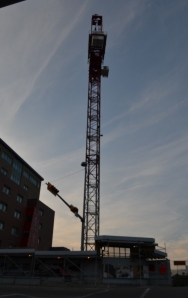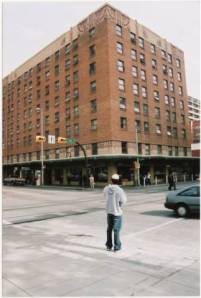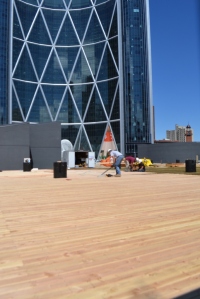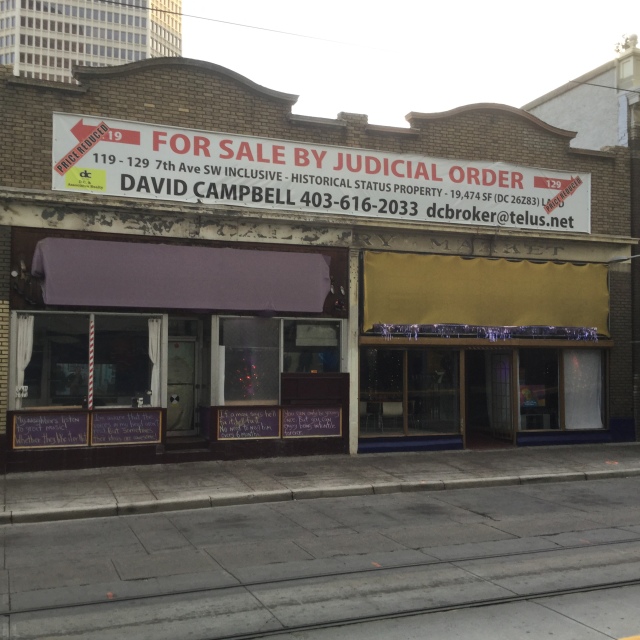
I have been wanting to write about this space for quite some time. I have always needed a reason to write about it, and now I have found the reason.
The space is Uptown 7th.
Located in the Delamere Block at 125 and 127 – 7 Avenue SW, it is located directly across from the First Street C-Train Station. It can best be described as a bit of an outlier when speaking of art galleries in the city.
The primary face to this project is a J.J. (Jonathon) Sunstrum. Also involved his partner Kayla Shimbashi.
I first met Jonathon when he gave me a tour of the original space shortly after he took it over and I was actively researching art spaces in Calgary for the past 100 years. It was in pretty rough shape then and the space that was predominately used is what is visible from the street now. When he refers to the space, it is usually as an “art gallery under renovations” or some variation thereof. It is for this reason I became interested in the space, and have remained so since that time (partly because I pass it so often).
Sundstrom took possession of the former Express Café space on October 3, 2012 which was located in the 125 space. The Express Café began operations in 1980, and was closed by the Health Board in January 2012. This was the beginning of the Uptown 7 space.
Uptown 7th expanded to include the neighbouring space at 127, probably at some point in either 2013 or 2014. This space is more suitable for art exhibitions as it has better lighting, larger windows, level street access and the floors are probably in better condition.
Who is J.J. (Jonathon) Sunstrum?
I could find very little information available on him.
As a result I had to depend on what he himself provided on his website. In the Uptown 7th website, he has indicated that he previously owned the Powder Horn Saloon in Bragg Creek and the Mountain Pizza and Bistro also of Bragg Creek. As best I can determine the Uptown 7th website was probably created in 2013 and has only had a few minor updates since that time.
In the Uptown 7th website it would appear as if Sundstrom moved to Calgary during 2001. In 2007 he showed that has some local political ambitions by running for Mayor against the incumbent Dave Bronconier. During that election, there were nine candidates running. Sundstrom placed last, receiving 1813 votes (0.86% of the vote).
This was followed in 2013 when nine candidates also ran for the position of Mayor against the incumbent, Naheed Nenshi. Sundstrom placed 8th receiving 775 votes out of 262,577 votes cast.
Programming
The name for the gallery as best I can determine, and it is speculation on my part, is as a derivation of Uptown 17 which was the name of the BRZ for 17th Avenue SW. I suspect it is still in operation, but the focus has definitely changed in the past ten years or so.
I am quite familiar with Uptown 17 (now known as 17th Avenue Retail & Entertainment District) as I was actively involved in conversations with the BRZ as a result of my working in a commercial gallery which was located in the BRZ. We worked closely with the BRZ when it actively supported the visual arts and prior to the time when the approximately 10 (sometimes more, sometimes less) galleries all shared frontage onto the small section of the avenue between 4th and 10th Streets for approximately 20 years (or more?). Now, I think there is only one recently established gallery on the avenue and it does not have street frontage. At one time the BRZ championed the visual arts quite a bit and commissioned respected artists through a yearly(?) open competition to create murals to enliven the street.
Enliven the street it did, as there were some significant artworks created by artists such as Joane Cardinal-Schubert, Alexandra (Sandy) Haeseker, , Bill Laing, Barbara Milne, Gary Olsen, John Snow (destroyed in a fire), Wade Stout and I am quite certain that I am definitely missing others who should be listed.
I found an unattributed image of one of the murals that once was located on 17 Avenue on the internet without any indication of who took the photo. This is a work by Sandy Haeseker from the time when she was working on a large series of prints and paintings of English Sheep Dogs that she did for an extended period of time.
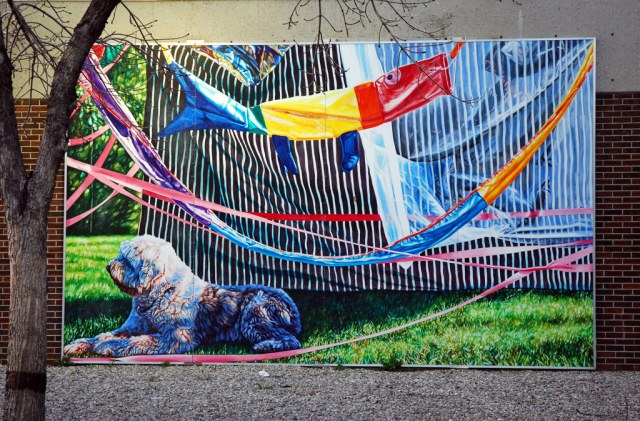
However in the name of progress many of those artworks were quietly removed, the maquettes were sold off. As an aside I once purchased a Dulcie Foo Fat painting that was a maquette for a mural that was never commissioned, that I subsequently sold. The demise of 17th Avenue as a gallery row occurred around the time when Shopper’s Drug Mart removed an old building located on the corner of 7th Street and 17th Avenue, a building which housed my favourite drinking establishment in those days – the old, dark, and dingy, brick-lined Mercury that had paintings of Brad Harms on the wall. Usually there was a fluctuating number of artist types who would meet every Friday after work and regularly stay from early to quite late in the evening usually ending up getting serenaded by the sounds of Sideshow Sid and his epic collection of vinyl. The death of the gallery strip was followed shortly thereafter by similar action the block west where the Best Buy is currently located. Both of these buildings were not in sympathy with the buildings in the area. In my opinion, it became the death of the strip as a viable place to do business as a small business owner, and now has the personality of a factory outlet by comparison. The ascent of the Red Mile which was also just starting around the time when the entire cultural change of that street became noticeable.
But I digress after this small walk down memory lane.
Back to Uptown 7th.
Somewhere along the way, I recall seeing a defaced Uptown 17 poster/pennant/ flag in the window of the Uptown 7th space. Someone had painted over(?) the #1 in 17 but otherwise everything else was the same. Those flags are not used any more, so I am sure that it was salvaged in some way, probably around the time, or before Uptown 7th became what it is now.
As a gallery, there have been surprisingly few exhibitions. The space which I have attended art exhibitions (the 127 space) is marginal at best. From sources that I believe correct, there is black mold in the interior spaces and the building roof leaks into the spaces below. It is probably unheated and is lit by construction lighting and heated by electrical space heaters. Quite frankly the buildings have been neglected for a number of years (probably decades). I am sure that the conditions predated the beginnings of Uptown 7th.
Sometimes you have to work with what you have. I am trying to be as objective as possible. This no doubt affects the type of shows that can be presented, and to an extent the type of art that will be presented.
The most visible aspects of the programming are the regularly changing messages, quotes and jokes that are placed on the blackboard of the 125 building exterior. The music (usually CKUA) and the large screen TV in the window often plays older movies. All these are seemingly meant to entertain those waiting for the C-Train on the station across the street.
The 127 space, occasionally has exhibitions, events and occasionally features backlit dancers at night that perform Latin dances that are usually out of synch with the music playing outside.
Because of this, I often look at the space as being a performative type of venue whether intended or not. There is a theatrical type of element present in everything that this space does. In so doing it does play to a core cultural attitude for the city.
One cannot deny the importance of theatrical, musical, dance, festivals, entertainment (I include sports here) and how these activities are viewed as core cultural values in the city. This often is done to the exclusion of the visual arts and those small little niche markets mentioned above that can be defined as elitist by some (i.e. chamber music, modern dance, etc.) except for their small core constituencies. Why this is, I do not know.
When there were traditional exhibitions, and the last show was about a year ago in November 2015, they usually featured artists that fell under the radar and are not part of the traditional gallery community. I am aware of a number of the artists who have shown work in the space through just being active in the community and talking to whomever will listen – even though I do not operate a gallery anymore, nor am I really involved. But when I was, I loved given unproven artists a break, even though I didn’t always sell their work and sometimes showing their work cost me more money than it was worth. For many of these artists, just having the chance to show their work is a small success. A career is built upon a series of small successes. Many of those artists have never forgotten me and usually want to chat me up when we cross paths and usually ask when I will get back into the business again.
These shows usually lasted for a couple days to maybe a week in length. They are as follows:
- Watercolours by 17 year old artist Natalie Slaba – November 2015)
- Paintings by Mateja Šmic (or alternatively Mateja Schmitz) – October 2015
- Paintings by Enriquito Selfismo – September 2015 (a Cuban artist that I understand is now living in Florida)
- Traditional b&w photography by Clarke Kinaschuk – August 2015 (now living in Toronto?)
- Paintings by Enrique Hernandez (Selfismo?), Yulin Qin and Juyan Chen – June 2015 (Grand Opening event)

The space with the most amount of activity is the apartment above 129. It is here that Sundstrom and Shimbashi reside (November 15, 2016 edit: This information is incorrect as the space is used as an office instead, as will be discussed further in an upcoming posting). What we see here is bubbles that are often discharged at random times of day and night from one of the upper storey windows. It creates a bit of a magical effect. While waiting for or riding the C-Train I have heard more than a few times people commenting on this part of the space. I have seen children trying to catch the bubbles, occasionally an adult too.
What benefit does this space provide?
I remember this section of the street from when I was still in high school. Occasionally, after school, I would go downtown with some of my fellow classmates. There was an arcade in one of the spaces, possibly below the residence. I also remember being propositioned to purchase drugs on this section of the street periodically during that high school timeframe as well.

When Art Central opened, this section of the street definitely was seedy. There is no question about that. It was an area of urban blight. It was a section of downtown that was considered to be unsafe by many people and an area to be avoided.
Around the time that Art Central opened (across the street and other end of the block from Uptown 7th) the C-Train platform was moved from between 1st and 2nd Streets to it’s present location between Centre and 1st Streets. During this time there was a C-Train platform on the south side of the street which was removed and relocated one block to the east where the current Centre Street platform now resides adjoining the Hyatt Hotel and the Calgary Convention Centre.
Approximately when both C-Train platforms were relocated and Art Central opened, Heritage Property Corporation purchased a series of these buildings. For a number of years Heritage Properties tried to create the Seventh Avenue Autopark Inc. which was a driverless, automated parking lot which was to be located directly above these buildings. This would allow the refurbishment and rehabilitation of the buildings similar to what they did in the Lougheed Building around the corner on 1st, which houses the Grand Theatre and buildings that once housed the old Calgary Public Museum.
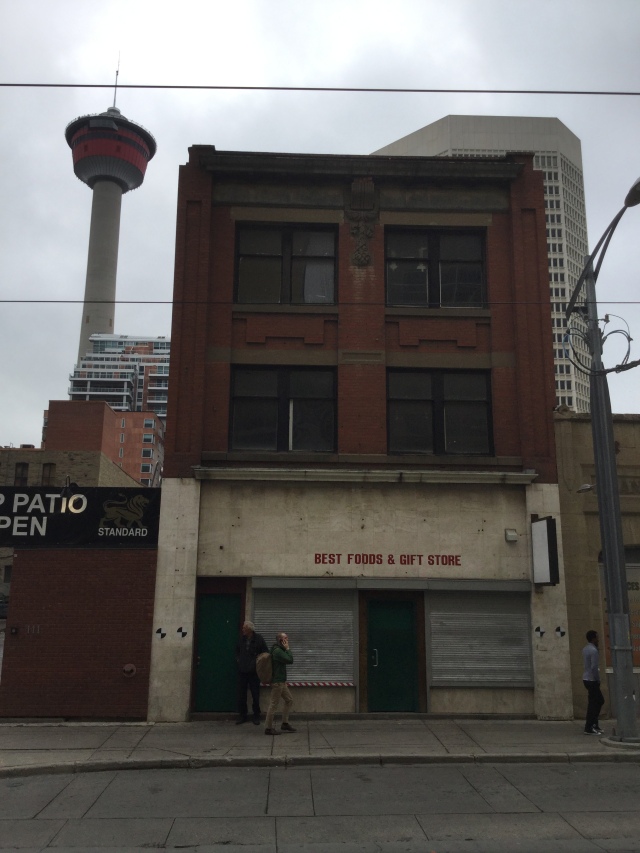
Presumably around the same time, there was a forced eviction of “undesirables” who were residing in the three-storey Stuart Block. It is this building in the photo above. Because so many of the people who used this building as a home lived on the margins of society there was little uproar about the forced eviction. However, This is My City Society in cooperation with the High Performance Rodeo presented a performance which addressed the last days before the eviction as part of the Cultural Capital activities during 2012. The building outside for the most part has been vacant since that time.
This all was taking place around the same time that the York Hotel and the Regis Hotel were getting vacated; the Art Central project was nearing completion; and The Bow building was beginning; the Calgary Convention Centre was expanding and the Hyatt development was happening. There was definitely some over-riding desire to gentrify the few blocks in that area during that time.
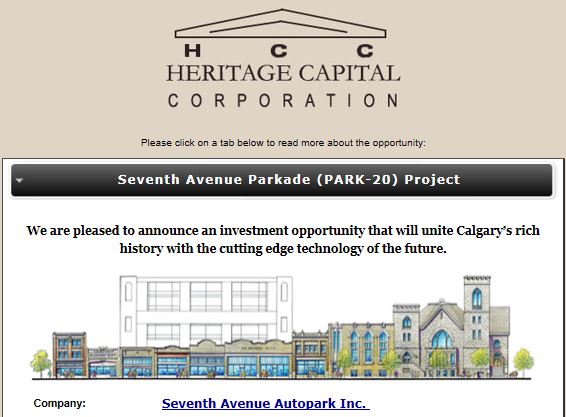
In the end, numerous attempts were made to City Council to make the auto park project happen. Ultimately, it never got off the ground. No doubt, there was substantial amounts expended to do the engineering reports and other related expenses. Having the buildings mostly vacant, and the few that were occupied were probably barely covering operational costs for the remaining buildings. With the local economy in a tough spot, and the last attempt to make it happen got shot down (again) around the time that the price of oil collapsed in 2014, that probably was the end of the road for the financial viability of this project. In some ways, I am surprised that they lasted as long as they did. As a result, the buildings were placed into receivership (or bankruptcy) as evidenced by the photo at the top of the page.
Legacy of this project
The biggest legacy to this project is public safety. With this project being where it is and activity happening all the time, Uptown 7th has become the eyes on the street. Often we will see Sundstrom on the street doing things like sweeping up cigarette butts and trash. He will be up on the roof shovelling off the snow. He is out there often. By blowing bubbles from an upstairs window the human presence is evident.
By doing these things it has created public safety for C-Train patrons that may not be as noticeable at other downtown C-Train stops.
For illustration, I will use the Centre Street platform located the next block over as an example. Here there is no human presence across the street after hours where the old Regis Hotel (cardboard is currently in the windows), the old Calgarian (now a fitness centre active during the day) and the Legion #1 which are all located in that block. In addition to this there are no C-Train platform entrances to either the Convention Centre or the Hyatt leaving the platform virtually unattended at any point outside of the business and daylight hours in the downtown core. There are a few small businesses that keep their doors locked and a Calgary Transit ticket place that is busy at the end of every month and various points in between. There also is some public art piece of standing people which allows for a place to blend in with the sculptures and rest while taking advantage of the heating vents located below them, where police will often visit at night to check on those who like to hang out there.
When comparing both the Hyatt block and the one located where Uptown 7th is located, there is a significant difference in terms of activity. The Palomino usually has people on the street most evenings at one end of the street. In the middle, they both are the same with unoccupied heritage buildings with Uptown 7th on the other end. The platform of course may change once the Telus Sky project is completed in a couple years, as I understand there will be a residential component to it.
There is a measurable difference in the number of transit customers who wait on the two platforms after hours, using comparable times.
Although the cultural significance of the art gallery is debatable, the appearance of safety that has come with the gallery and the activity surrounding it, is undeniable.
This all brings me to the compelling reason to write about Uptown 7th
I often pass by Uptown 7th at various times of day and night because of the C-Train. I also often read the chalk board messages, just like many others also do.
About three weeks ago, early October (maybe it was late September) there was a message indicating that the buildings may be sold and that they would find out on the following Monday. I paid more attention as a result. Early the following week, I noticed that there was a message indicating that the building had been sold.
By the time I remembered to bring my camera with me, the message had been erased and replaced with another. Nevertheless, we do know that the building indeed has been sold. This is confirmed from the listing agent who has stated this fact on their website.
My assumption is that because it was a judicial sale, possession would take effect as quickly as is reasonably possible. A possession date, that starts at the beginning of the month after receiving court approval would seem like a plausible timeframe.
This means that the possession date could reasonably be expected to occur as soon as today (November 1, 2016).
Therefore, we may see changes to this block in the very near future.
I would also think that something big will happen in terms of development in this block in the near future. It will probably will not happen right away. I would think that with this block of buildings, the purchaser owns enough property on the block, that it is merely just a matter of time before something moves forward and this block will be gentrified.
A number of years ago in 2006, when The Bow building was still in development, Bob van Weegan penned a story in the Calgary Herald, which talked about heritage buildings. This quote which I feel is as relevant now, as it was then, is from that story.
When an old building is sold to developers, that is often bad news for heritage. In some cases, the city or province may provide funding or tax breaks, or use overriding legislative power to preserve a building. But typically when heritage is at stake, there is a negotiation between the developer and public authorities. If a developer is sympathetic and can achieve what he needs on a site without destroying heritage, there is a good chance for a win-win outcome.
I close with this thought to muse upon. Recently, there is an increased city-wide awareness that heritage buildings should be protected (in some way, partly through the Century Homes project which I was happy to be part of). Is it possible that the new project will incorporate the historical buildings in a manner similar to what was done in the Hyatt and Calgary Convention Centre expansion along Stephen Avenue Walk?

My guess is that something like that probably will happen, and it probably will not be a small project either.
I will be watching to see what developments are waiting in the wings.
___
Reference (quote):
Bob van Weegan. Calgary Herald. Will EnCana’s twin towers make the most of our heritage?, June 11, 2006.


